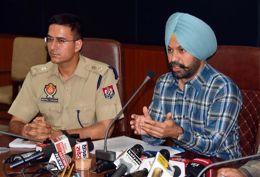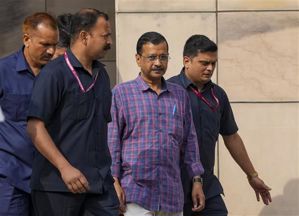
Captain MS Dhoni has no options in fast bowling as all the seamers picked up for T20I series are medium-pacers. PTI
Subhash Rajta
Tribune News Service
Dharamsala, October 3
About three months back, after losing the ODI series against Bangladesh, MS Dhoni had made a scathing comment on the Indian fast bowlers. The skipper, who usually refrains from commenting on the players in public, had said that the time had come for the team to decide whether they needed fast bowlers or the line-and-length bowlers with greater control.
On the evidence of the team fielded in the first T20I, or rather the squad picked for the T20I series against South Africa, it could be said that Dhoni has made up his mind — he doesn’t want pace and the lack of control that comes with it; he wants medium-pacers who, he believes, give him better control on the proceedings.
India have picked just the medium-pacers — Bhuvneshwar Kumar, Mohit Sharma, S Aravind and Stuart Binny — for the series, leaving out Ishant Sharma, Umesh Sharma, who had a great Test series in Sri Lanka, and Varun Aaron. However, despite getting the bowlers he wanted, he couldn’t get the desired result as the Indian attack failed to defend a massive 200-run target. Yes, it was a pretty close affair and the game could have gone either way; yet it doesn’t change the fact that India had a huge total to defend.
The point is, did India miss a bowler with some serious pace in Dharamsala? Could someone quicker, bowling the last few overs, had made it a little more difficult for JP Duminy to steal the game from India? Nobody could say it with certainty but it’s a fact — most batsmen admit it — that no one wants to play a really quick bowler. Yes, batsmen aren’t really afraid of handling pace these days – remember, Dale Steyn and Mitchell Johnson too get carted around in the T20Is – but still, given a choice, any batsman would be happy to play a 130 kmph bowler instead of the one bowling at 145 kmph.
Besides, a quick bowler would have given some variety to the attack, which looks monotonous, in terms of pace, with Kumar, Sharma and Aravind bowling roughly at the same speed.
Moreover, if the conditions in the two other games demand the inclusion of a faster bowler, India wouldn’t have one to pick as there is none in the squad.
It could be argued that South African pacers, far quicker than their Indian counterparts, fared no better as they too conceded 199 runs. However, there’s a significant difference. The South African pacers were smashed by one batsman (Rohit) who was having an excellent day; on other batsmen they managed to have some kind of control. “We were thinking of chasing 220 plus when Rohit was batting,” said JP Duminy, implying the South African bowlers did manage to rein in the other Indian batsmen.
The Indian pacers, on the other hand, couldn’t keep any batsman under check, except for Faf du Plessis who was dismissed early on. The only time India looked in control was when R Ashwin was bowling. Apart from that phase, the South Africans had a free run against the Indian bowlers.
For Dhoni, it was his third defeat in the last four matches as captain — that’s something that hasn’t happened very often in the past. The skipper was obviously disappointed with his bowlers, but this time he wasn’t as harsh on them. “We did well with the bat but we could have done better in bowling. You can’t give away too many runs in one over. Yes, there will be bad overs, but one still has to restrict the runs conceded to 12-15 runs, that helps the bowler bowling the next over,” he said.
Maybe the skipper was mindful of the tough conditions the bowlers had to operate in due to the evening dew.
Given Dhoni’s clear preference for medium-pacers and Virat Kohli, the Test skipper, being an avid fan of genuinely quick stuff, the Indian pace attack is going through interesting times.
67: Runs conceded by India in the Powerplays, the third highest they have conceded in these overs in any T20I and the most they have conceded in a Powerplay without taking a wicket. They had conceded 74 runs against Australia in 2013, the most they have conceded in the Powerplays in any T20I.
20: Sixes, the most in a T20I in India. While India hit 11 sixes, South Africa contributed nine. The previous most sixes hit in a T20I in India were 17 (SL vs India in Mohali, 2009).
7: Sixes hit by Duminy, which equaled the most hit by a batsman against India in a T20I. Four other batsmen have hit seven sixes in a match against India. Richard Levi’s 13 sixes against New Zealand in a match in 2012 are the highest.



























